YOU ARE VIEWING A DEMO REPORT
Beth Person

Toolkit: How You See the World
Law School Transparency
Introduction 00
Back to Table of ContentsHow you think about the world shapes how you interact with it. Your cognitive approach is not immutable; you can improve your thinking as you learn more about your cognition.
Your personalized report contains the following chapters:
Cognitive Super Power: Your dominant Go-to Behavior is your Superpower, one that is fast, easy to use, and you may not even know that you have it or use it.
Visual Type & Go-To Behaviors: This is a visual model of Carl Jung’s Psychological Types showing that each person uses all eight behaviors.
Cognitive Dynamics: Insight into what information you focus on and how you evaluate it as you think through the world around you.
Cognitive Gifts and Challenges: The plusses and minuses from how you look at the world.
Learning with Cognitive Preference: Learning never stops. Understanding your natural learning tendencies will provide you an advantage in taking in and processing new information.
Keys to Better Learning: This chapter is designed for a teacher or professor, but will help you get the most out of your learning in school and in life.
01 Cognitive Super Power - Expanded
Back to Table of ContentsThis section describes your Superpower; your dominant, "go to" behavior that is so natural, fast, and easy to access, you may not even know you have or are using it.

Super Analyzing
Beth’s Superpower
- Compelled to help by making certain everything is accurate and logically consistent
- Does everything in her power to ensure things are properly categorized, sorted, identified and labeled
- Beth may sometimes be overly critical in an earnest attempt to help and make things better
- She loves analyzing to uncover the one most perfect solution to a problem
- Beth typically thinks all problems can and should be solved by logic and reasoning
Good Day

System Thinker
Bad Day

Sarcastic Critic
Super Analyzing
Beth understands logic and analyzes or figures out the essential principles. That is what Super Analyzing is all about. Those with this superpower are constantly evaluating, defining, and identifying if something is correct or incorrect based on the sophisticated logical models and complex mental concepts they use.
For Beth it is very frustrating that most other people do not logically analyze or figure out their decisions. She often can't turn off the need to analyze things. Those with Super Analyzing are often dismayed because almost the entire world seems illogical or 'stupid' to them.
Her sophisticated analysis can sometimes result in a fairly biting wit. And when overused this can result in a perfectionist approach and evaluation of both herself and those around her.
It is also this constant mental sharpening that results in amazing progress on any problem that can be analyzed and solved by principles. Beth often thinks all problems can and should be solved by logic and reasoning.
Original work by: Sterling Bates Gene Bellotti © Step Research Corporation
02 Visual Type™ and Go-To Behaviors
Back to Table of ContentsThis section is a visual model of Carl Jung’s Psychological Types showing how you use all eight behaviors and which two are dominant for you.
Visual Type™ provides a visual guide to the predictive use and accessibility of each behavior and an instantly recognizable way to see differences between people. This helps individuals with self-awareness. It also helps others understand what they can expect from the individual. The goal of this section is to make it immediately obvious to non experts how the functions relate to each other and the person based on their whole type.
Analyze
Decide based on logically correct or incorrect and evaluate the best approachBeth uses an internal, logic-based decision-making process that focuses on what is correct or incorrect. Beth looks inside before making decisions, using her mind to create order, to organize and categorize information, identify anomalies, deduce probabilities and understand how things work.
Invent
Look to the new and different ideas and explore many possibilitiesBeth uses brainstorming, a verbal questioning to identify patterns that provide insight. Beth looks to Invent as her go-to behavior for gathering information, she prefers seeking answers through brainstorming, identifying patterns and innovation. Beth looks outside the box for answers, seeking something new.
Understanding Beth's Visual Type™
- Beth's largest go-to box is Analyze, showing her strength of doing fact-based analysis of the problem based on data, not conjecture or opinion.
- What few people see below the line is how analytical she is when making decisions.
- Beth's supporting go-to box is Invent: brainstorming new ideas, starting new projects, thinking out of the box and finding creative solutions to problems.
- Beth's other three top boxes - Stabilize, Insight, and Value - are drafted to support her Analyze function, which she experiences as her Superpower of Super Analyzing.
You use all eight Go-To boxes but we expect that you find certain ones easy and fun and others slow and tough.
Think of the box size as telling you how natural you are likely to find activities related to that mental function. The smaller the box, the more energy it will likely take you to do any related activities. The bigger the box, the more likely you are to get energy from doing related activities.
The largest box is your largest function or Superpower.
The boxes above the line are what other people see - they are extraverted. The boxes below the line are introverted and are below the surface.
If your main go-to box is introverted, your most commonly used mental function is invisible to others. If your main go-to box is extraverted, others cannot see your supporting introverted box.
- Exciting
- Quick acting
- Risk taking
- Details
- Immediate need
- Exciting
- Quick acting
- Risk taking
- Details
- Immediate need
- Remembering
- Tells it from beginning to end
- Recalls in time sequence
- Details
- Nothing is too old
- Remembering
- Tells it from beginning to end
- Recalls in time sequence
- Details
- Nothing is too old
- Sharing ideas
- Takes a global perspective
- Brainstorming
- Identifies patterns
- Is not bothered by details
- Sharing ideas
- Takes a global perspective
- Brainstorming
- Identifies patterns
- Is not bothered by details
- Gaining insight from the unknown
- Having the “AHA”
- Connects the unconnected
- Difficult to explain
- Processes randomly
- Gaining insight from the unknown
- Having the “AHA”
- Connects the unconnected
- Difficult to explain
- Processes randomly
- akes a removed or objective perspective
- Sounds level headed
- Works from a defendable position
- Uses external tools
- Arranges data logically
- akes a removed or objective perspective
- Sounds level headed
- Works from a defendable position
- Uses external tools
- Arranges data logically
- Invisible to others
- Everything is connected
- Developed with precision
- Nothing exists unless it is complete
- Systematic process
- Invisible to others
- Everything is connected
- Developed with precision
- Nothing exists unless it is complete
- Systematic process
- Everyone is at peace
- Wants everyone to be happy
- Appreciates others’ involvement
- Harmony in the moment
- Connecting with others
- Everyone is at peace
- Wants everyone to be happy
- Appreciates others’ involvement
- Harmony in the moment
- Connecting with others
- Shielded from others
- Timeless
- Peace within
- Going it alone
- Often visible only when violated
- Shielded from others
- Timeless
- Peace within
- Going it alone
- Often visible only when violated
Now
: Look to the present and immediate needs and explore what is currently availableNow is very adept at identifying details about something that is happening right now and can be acquired through the five senses. People using NOW tend to be very aware and in the moment, seeking tactics that they can implement right now. Now looks to the present and the immediate moment for solutions.
Engaging to Experience
Alive in the moment and aware of what the senses are able to immediately experience
What's Happening Now
Alive in the moment and aware of what the senses are able to immediately experience
The Now function triggers an immediate reaction to or an engagement of what is perceived, so it may appear as if one is quickly changing from one activity to another or shifting interest quickly from one thing to another.
People who prefer to or naturally use Now to acquire information report liking to "live life to the fullest" or "live on the edge". Often the physical risks are exciting. They also report doing things or saying things that get a recognition or a reaction from others in the moment.
Stabilize
: Look to the past, traditions and what worked and focus on consistencyStabilize is abot keeping an internal database of details that have been learned in the past. Stabilize compares today's data with past data to make an informed decision. People using Stabilize tend to check their memory, make comparisons to the past, and in general look to the past to verify information.
Reliving to Verify
Recalling the details of past experiences and reliving the motions that accompany them
Resurrecting the Past
Recalling the details of past experiences and reliving the motions that accompany them
When active, Stabilize might appear to be slow in responding or unmoved by the present moment. This is because the focus is not on the present event. Instead it is on examining all past similar experiences.
When people who prefer, or naturally use, this mental function share the experience it is as if they were sharing the video tape that is playing in the brain. They also know that the devil is in the details, so expect them to be uncomfortable leaving out the details when they are talking and wanting you to include the details when you are talking.
Recognize that the experiences being recalled may have occurred eons ago, yet they are being talked about as if they only occurred yesterday.
Invent
: Look to the new and different ideas and explore many possibilitiesInvent is about brainstorming, a verbal questioning to identify patterns that provide insight. People using Invent tend to prefer seeking answers through brainstorming, identifying patterns and innovation. Invent looks outside the box for answers, seeking something new.
Recognizing Patterns and Possibilities
Creating possibilities for the future and spontaneously recognizing patterns and connections
Envisioning to Improve
Creating possibilities for the future and spontaneously recognizing patterns and connections
Invent when active in a positive way tends to view the opportunities and possibilities positively. Information shared through this function may seem to be superficial or broad brush as the details or what is beneath the surface can be filled in later. The expressions tend to be global in nature.
Insight
: Look to how things connect, the future and predict possible outcomesInsight is about the process of identifying seemingly disconnected patterns to result in instant insight into a problem or situation. When using Insight people tend to visualize their goal or end result, focus on strategy, synthesize data almost unconsciously and predict results with surprising accuracy. Insight looks to and visualizes the future for answers.
Discerning the Essence
Synthesizing information and identifying the central theme, vision, or significance
Insight of Holistic Meaning
Synthesizing information and identifying the central theme, vision, or significance
The insights that are received are like nuggets of gold; however, often the person receiving the nugget does not know how to immediately explain it to others so that they perceive it as a nugget of gold as well. This is often because the nugget appeared as a flash of light or insight without supporting information, so when one attempts to explain why the insight should be trusted the mind is blank. Reflection time is almost always needed to allow some bits of information to drift into consciousness to support the value of the insight. Memory is symbolic and images and ideas are ever-changing.
Execute
: Decide based on measurable goals and drive towards objectivesExecute is about plans, organizing, schedules, and measures. Execute structures the decision-making process by directing and interacting with other people. Execute focuses on measurable goals. When using it, people tend to think out loud, notice quickly when something is out of sequence or order, set objectives and criteria for success, and create step-by-step procedures. Execute looks to influence and organize the world, even when not solicited to do so.
Planning and Regulating
Establishing goals and applying objective analysis to arrive at a logical, defendable decision
“Operationalizing”
Establishing goals and applying objective analysis to arrive at a logical, defendable decision
With Execute everything is supported with logically analyzed data. Execute analyzes information within specific boundaries. Western states are different from northeastern states. We can think of Execute as establishing boundaries for the problem or boundaries regarding information that will be considered. Execute involves living by specific rules, regulations and laws and believing others should, as well.
Analyze
: Decide based on logically correct or incorrect and evaluate the best approachAnalzye is about using an internal, logic-based decision-making process that focuses on what is correct or incorrect. When using Analyze people tend to look inside before making decisions, using their mind to create order, to organize and categorize information, identify anomalies, deduce probabilities and understand how things work.
Understanding Systems
Repeatedly applying system analysis to data to fit them in one’s subjective mental framework
“That’s Better Defined This Way.”
Repeatedly applying system analysis to data to fit them in one’s subjective mental framework
These frameworks are built with precision and take a long time to be completed; therefore, they are not going to be quickly discarded in favor of a different framework. Because this is an introverted function the framework or system is not visible to others. Others often do not get a glimpse of the framework until they arrive at a decision that is not consistent with the framework, at which time they get to witness the volcanic explosion.
One can think of Analyze as an internal filing system. Each file contains sub-files, which contain sub-files, and so-on. Thus, when one is using Analyze, the time it takes to evaluate information may take a substantial amount of time, as the person must check to see if the information fits within one's complex filing system. If there is no place in the filing system for the piece of information to go, it will be rejected until more information is received.
Consideration
: Decide based on people's needs and empathize with othersConsideration is about giving the other person's personal needs high importance in making a decision. Consideration gives priority to the feelings of others. When using Consideration people tend to be friendly and considerate, try to create harmony between other people, act with kindness, and will disconnect with people who do not show that they care. Consideration looks to help others grow.
Affirming and Validating
Expressing appropriate concern and appreciation so group harmony is maintained
“You Really Did a Great Job”
Expressing appropriate concern and appreciation so group harmony is maintained
Consideration is genuinely 'other focused.' It is the mental function used to assess how others will react to certain decisions. It involves knowing the appropriate thing to do and is satisfied when others are content and working together.
This function evaluates based on the possible impact on others. It strives for peace externally or peace among others and is about making sure others are not disturbed, annoyed or in conflict. Consideration involves conversing and connecting with others, being with others, appreciating others and celebrating with others. It's all about 'others.'
Value
: Decide based on ethically right or wrong and sync with individual valuesValue is about aligning personal missions with being understanding. Value decides in a way that promotes win-win solutions with the priority on other people's feelings and their own personal ethics and morals. When using Value people tend to make decisions that focus on what is right or wrong according to their own internal values. They then expresses their internal values through external actions.
Liking or Disliking
Feeling internal tranquility when reality matches what is uniquely and deeply valued
“This is the Only Acceptable Way”
Feeling internal tranquility when reality matches what is uniquely and deeply valued
These values are shielded and protected from attack by others and thus may make us feel alone, vulnerable, or even on the defensive. There is a bit of mystery as to who this person is and there is a sense of tranquility and personal serenity. The values involved change very little, if at all, over time.
When these values are attacked, the reaction is often as shocking to those triggering the reaction as it is to the one who is reacting. It is as if a sudden, unexpected explosion has occurred that is the opposite of the serene inner harmony that is generally sought. Value strives for peace internally or an internal calmness and sense that everything is right.
Original work by: Sterling Bates Gene Bellotti Robert McAlpine © Step Research Corporation
03 Cognitive Dynamics
Back to Table of ContentsHow are you inclined to think about things? Cognition at its core deals with kinds of information and kinds of evaluation processes.
Analyzing
Interpreting
Analyzing
Gain leverage using a framework.
Analyze a problem using a framework, and find an angle or leverage by which to solve it.
- Analyzing
- categorizing
- evaluating according to principles and whether something fits the framework or model
- figuring out the principles on which something works
- checking for inconsistencies
- clarifying definitions to get more precision
Interpreting
Explore the emerging patterns.
Explore imaginative potential possibilities as they emerge.
- Interpreting situations and relationships
- picking up meanings and interconnections
- being drawn to change “what is” for “what could possibly be”
- noticing what is not said and threads of meaning emerging across multiple contexts
04 Cognitive Gifts and Challenges
Back to Table of ContentsThis section shows your likely gifts and challenges based on your cognitive preferences
Analyzing
Brainstorming
Analyzing
What is the most precise and refined answer?
Likely Gifts from Effective Use
- Focusing on logical reasoning based on an internal principle, framework, or mental model
- Noticing, correcting, and refining inaccuracies in logic and word usage
- Seeking objective truth to find a better, or the one best, solution to a problem
- Asking questions and playing ‘devil’s advocate’ to get all relevant information
- Finding leverage points within the current context to influence and solve problems
- Engaging in complex, connected critical analysis to provide simple, elegant answers
Likely Limits from Overuse
- Rejecting thoughts that could be relevant because they don’t fit the mental model
- Appearing arrogant, critical or detached from the issue or people involved
- Being slow to act or hesitant to make a decision
- Getting stuck in ‘analysis paralysis’ with too much information to sort out
- Forgetting that rules and objective standards were created for a reason
- Being unable to articulate logic so others can understand
Brainstorming
What patterns are emerging and what could they mean for the future?
Likely Gifts from Effective Use
- Scanning data in the environment to connect the dots, see patterns and make connections
- Seeing how circumstances may be altered to tap potential in multiple ways
- Looking for possibilities, options, opportunities, and new ways of doing things
- Communicating with suggestions, ideas, ‘what-ifs’ and ‘maybes’
- Maintaining flexibility and enthusiasm while pushing for change
- Generating excitement in others about exploring new horizons
Likely Limits from Overuse
- Ignoring the evidence of the tried and tested in favor of novelty
- Forgetting how concrete reality may limit options
- Generating too many alternatives to be decisive
- Moving on rather than following through
- Wanting to change things for the sake of change
- Failing to stop generating options even when others seem overwhelmed
05 Learning with Cognitive Preferences
Back to Table of ContentsFour instruction approaches based on cognitive processing preferences
Preferred Learning Approaches
More Likely Beth
 Let Me Lead As I Learn
Let Me Lead As I Learn
Question & Connection
- Start with the big picture, not the details
- Let me dream big without penalties
- Let me find a new way to do it
- Let me experiment
- Give me choices
- Keep changing what we do
- Let me teach or tell someone what I’ve learned
- Let me be in charge of something
- Let me talk or work in groups
- Let me come up with my own ideas
Less Likely Beth
 Let Me Do Something
Let Me Do Something
Experience & Movement
- Start with hands-on activities
- Give me steps to follow
- Build on what I already know
- Tell me why I’m learning something
- Give me chances to talk, move, and work in groups
- Set a realistic deadline
- Give me examples
- Provide clear expectations
- Go light on theory
- Let me apply it immediately
 Let Me Follow My Own Lead
Let Me Follow My Own Lead
Vision & Interpretation
- Let me delve deep into things that interest me
- Avoid repetition and routine
- Let me figure out for myself how to do things
- Give me choices
- Listen to my ideas
- Let me learn independently
- Let me start with my imagination
- Help me bring what I envision into reality
- Give free rein to my creativity and curiosity
- Provide references for me to build my own knowledge base
Least Likely Beth
 Let Me Know What To Do
Let Me Know What To Do
Structure & Certainty
- Set clear expectations and goals
- Show me examples
- Provide the steps in writing
- Answer my questions as I have them
- Give me time to think
- Let me work with and memorize facts
- Avoid too many surprises
- Build on what I already know
- Let me know along the way if I’m doing things right
- Connect content with past efforts and experience
06 Keys To Better Learning
Back to Table of ContentsHelping a student identify and leverage their keys to better learning
Identifying Keys to Better Learning
- Gain credibility and trust by being flexible and allowing her time to reflect on her own.
- Offer guidance in an animated and enthusiastic manner.
- Give her the underlying significance of what you are suggesting and emphasize how considering this can expand her perspective and open up possibilities to think creatively.
- Express information objectively so Beth will best hear you.
- Don’t be intimidated if Beth is skeptical about the concepts you provide, this is how she learns best. Act as a neutral sounding board so that she can feel comfortable being herself around you – what she wants most is to grasp the logical basis of ideas.
- Participating in group discussions and doing oral presentations instead of independent study and written reports.
- Hearing about details and specifics first instead of listening to topics described in big picture terms.
- Building social connections and people skills instead of running statistics or analyzing data.
- Setting benchmarks and scheduling appointments to monitor understanding and progress instead of free-flowing course goals and ad-hoc get-togethers to strengthen learning.
- Tell Beth that when people are feeling confused on any topic, it can affect their experience of school even if their problems aren’t directly related to their coursework. At such times, people tend to seek clarity in different ways.
- To help Beth gain perspective, have a discussion with her where you support her in drawing on her natural style of reasoning by asking "What is the most logical and objectively correct thing to do?"
- Reassure Beth that the point is not to have the perfect answer, but instead to free up her thinking and start a conversation about options.
- If Beth is really stuck, you may want to try asking her this stretch question designed to shake up her typical approach to unraveling confusing or difficult issues: "What is the most immediately enjoyable thing to do?"
- Help Beth get the most out of the stretch question above (especially if she has trouble with it) by explaining that “This question is actually one that some people – people quite different from you – would naturally ask themselves, so it’s totally normal that it might seem foreign to you, or, for you to feel that it is not even a valid question to consider. So, while it probably feels a bit awkward, being willing to think about this question and trying to look at things from another’s vantage point, might just turn out to be a useful and important way expand your thinking.”
- Use this as an opportunity to encourage Beth to stay curious about the methods others use to learn and grow when faced with something confusing or difficult. Even when these methods don’t match hers, she may be surprised at what she discovers, even if all she discovers is how not to do things.
Practice new skills: Homework/In-Session Activity
- Ask Beth to look at this list of things that could support her learning and pick out TWO items.
- Have Beth brainstorm possible ways of adding these to her routine or increasing their frequency if she is already doing them. This can be homework or you can work on it together in the session.
- Suggest Beth reflect on how these could improve her learning experience. Ask Beth:
- What helps you stay positive and motivated about school? How might some of these strategies increase those feelings?
- What helps you to cope when things feel tough or overwhelming? How might some of these techniques improve your coping skills yet further?
LIST OF ITEMS TO GIVE Beth – She picks TWO
Beth Person
Enhancing Your Learning Experience

Instructions For Using This
- Look at this list of things that could support your learning and pick out TWO items.
- Brainstorm possible ways of adding these to your routine or increasing their frequency if you are already doing them. It is okay to have someone with work you on this part.
- Reflect on how these could improve your learning experience. Questions to ask yourself:
- What helps you stay positive and motivated about school? How might some of these strategies increase those feelings?
- What helps you to cope when things feel tough or overwhelming? How might some of these techniques improve your coping skills yet further?
I can enhance my educational experience by:
- Having unstructured free periods where spontaneity is the order of the day.
- Taking courses that highlight cutting edge theory to keep my enthusiasm stoked.
- Finding time and space for contemplation on a regular basis.
- Being in the company of respected and trusted others whose competence and intelligence I admire.
- Prioritizing fun, laughter and taking care of my physical needs as an important component in maintaining academic excellence.
Original work by: Elizabeth Hirsh Katherine Hirsh © Step Research Corporation

 Now is about immediately engaging the world around us. We do this by perceiving information through any of our five senses. We might even be using multiple senses simultaneously. Remember we are talking about concrete information; otherwise, it would not be information we perceived through one of the senses.
Now is about immediately engaging the world around us. We do this by perceiving information through any of our five senses. We might even be using multiple senses simultaneously. Remember we are talking about concrete information; otherwise, it would not be information we perceived through one of the senses.
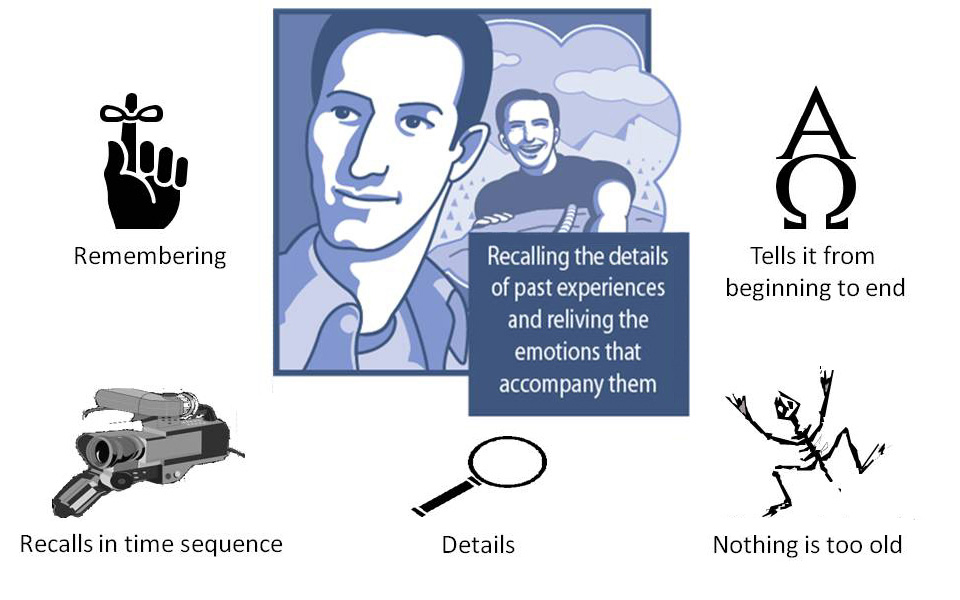
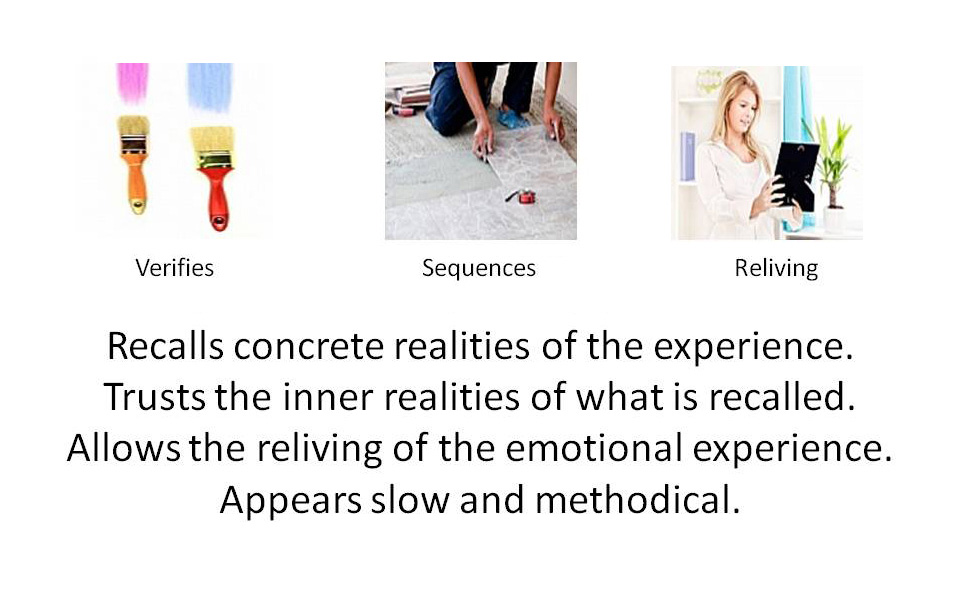 Stabilize is about checking out the present information by comparing it to previous experiences with similar information. We do this by recalling and reliving the past experiences in our lives. These are concrete experiences that include the emotional experiences or reactions we had to the experience being recalled. The recalled experiences are recalled from start to finish and if they are shared everything from start to finish must be shared.
Stabilize is about checking out the present information by comparing it to previous experiences with similar information. We do this by recalling and reliving the past experiences in our lives. These are concrete experiences that include the emotional experiences or reactions we had to the experience being recalled. The recalled experiences are recalled from start to finish and if they are shared everything from start to finish must be shared.

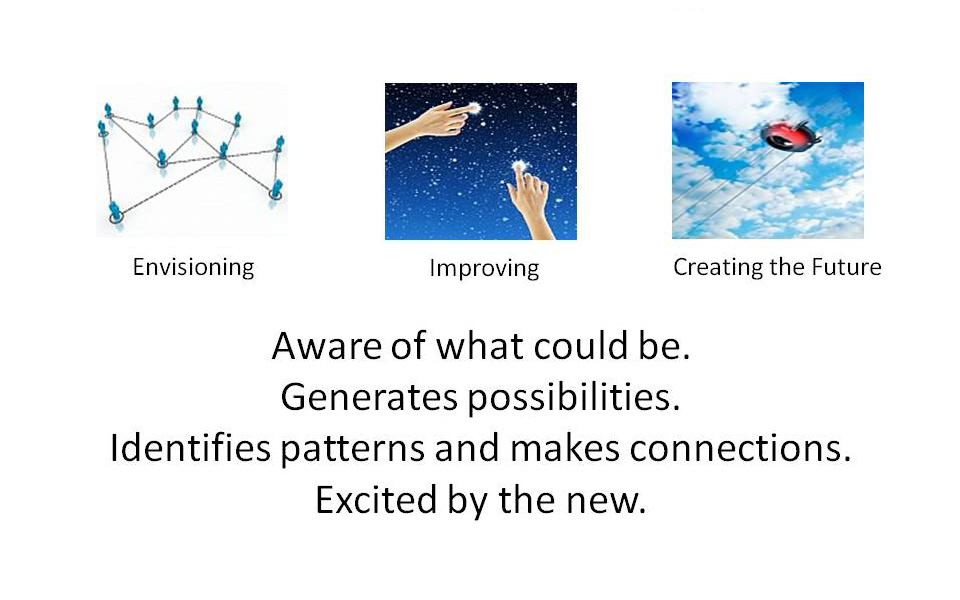 Invent is about identifying possibilities and opportunities related to what is happening in the real world. It is generating new ideas based on old ones. It is creating new ideas based on what someone else has shared. It expands one idea into many possibilities without the need for precision or detail.
Invent is about identifying possibilities and opportunities related to what is happening in the real world. It is generating new ideas based on old ones. It is creating new ideas based on what someone else has shared. It expands one idea into many possibilities without the need for precision or detail.
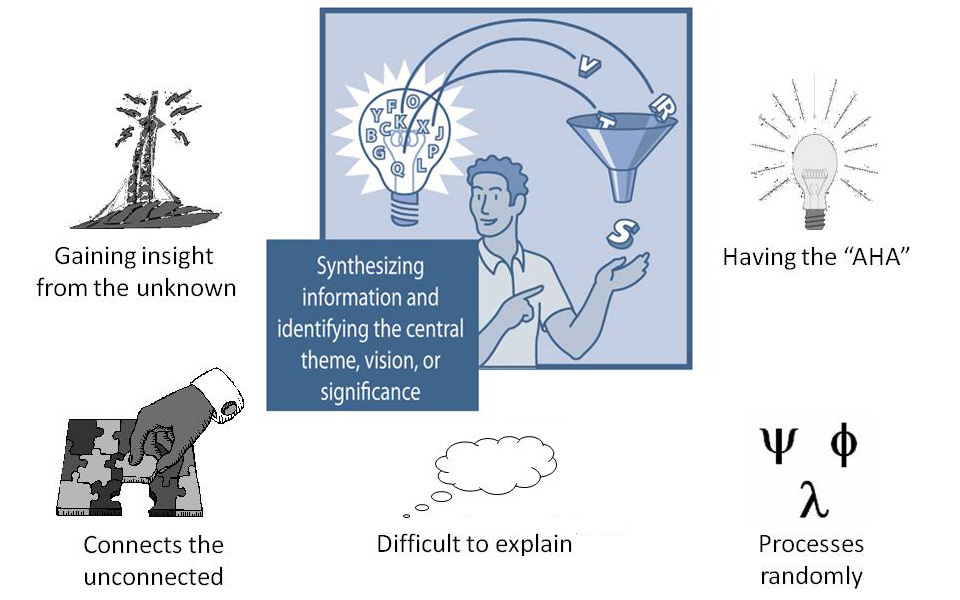
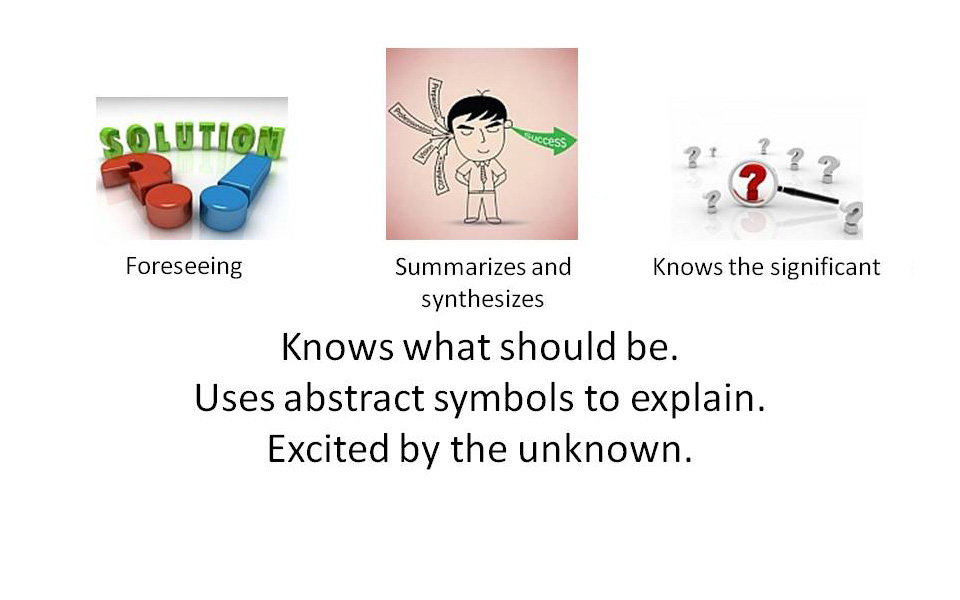 Insight identifies the opportunity or possibility that is the "best" without really knowing how it was identified. It is like a receiver getting signals from an unknown TRUSTED source. It tends not to focus on intermediate steps instead focusing on the end goal. One might connect with Covey's "Start with the end in mind" as an introverted intuiting approach.
Insight identifies the opportunity or possibility that is the "best" without really knowing how it was identified. It is like a receiver getting signals from an unknown TRUSTED source. It tends not to focus on intermediate steps instead focusing on the end goal. One might connect with Covey's "Start with the end in mind" as an introverted intuiting approach.
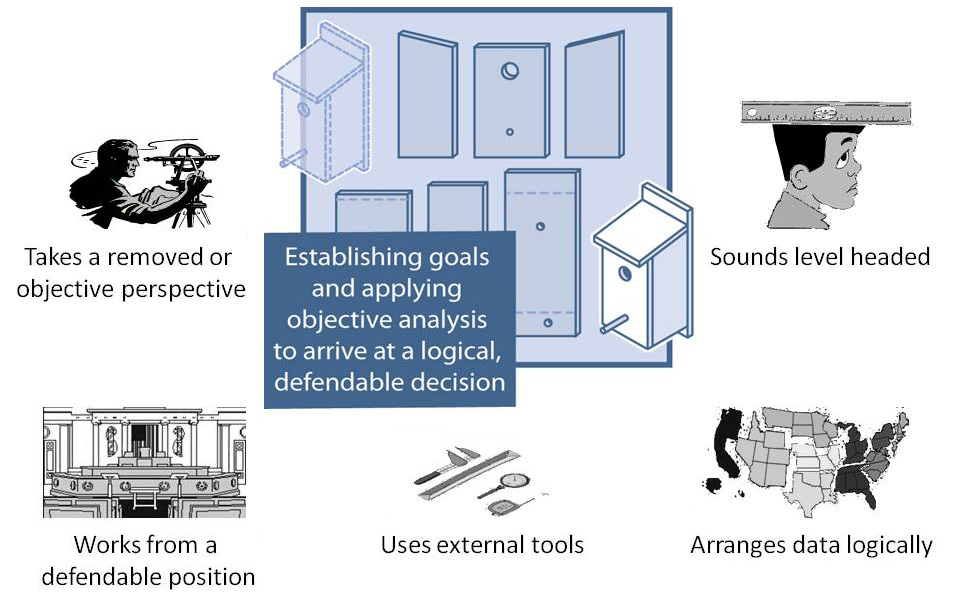
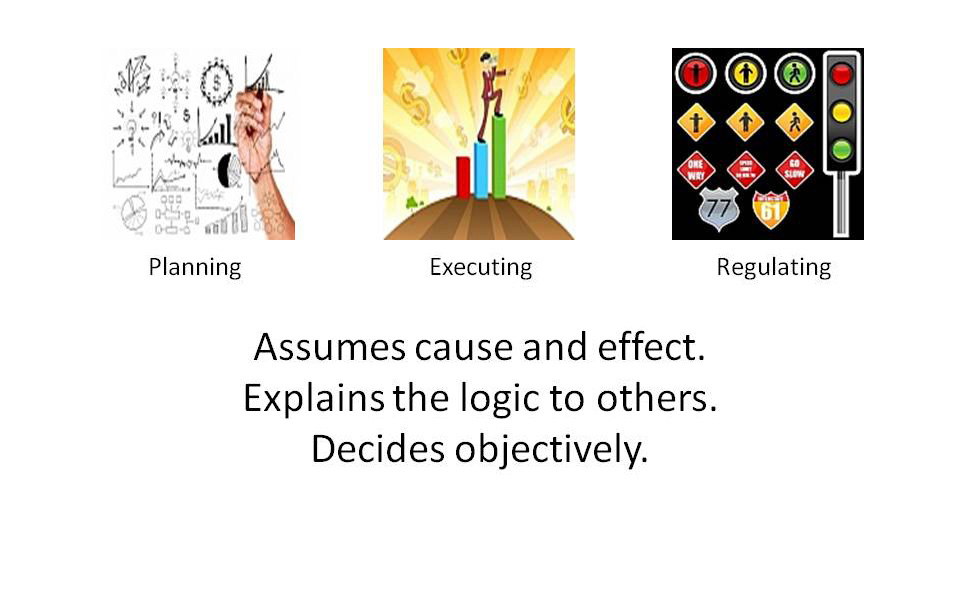 Execute uses accepted tools and techniques to evaluate the information much like surveying instruments are used to determine a specific location. This process organizes information in an orderly manner so the information can be analyzed objectively or impersonally.
Execute uses accepted tools and techniques to evaluate the information much like surveying instruments are used to determine a specific location. This process organizes information in an orderly manner so the information can be analyzed objectively or impersonally.

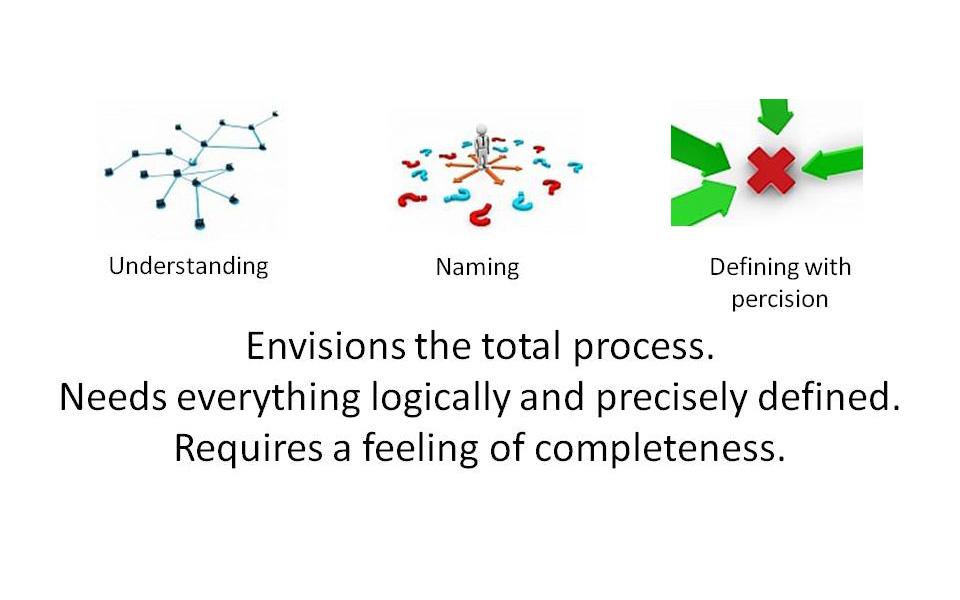 Analyze evaluates information based on how consistently and precisely the information fits within established internal systems or frameworks.
Analyze evaluates information based on how consistently and precisely the information fits within established internal systems or frameworks.

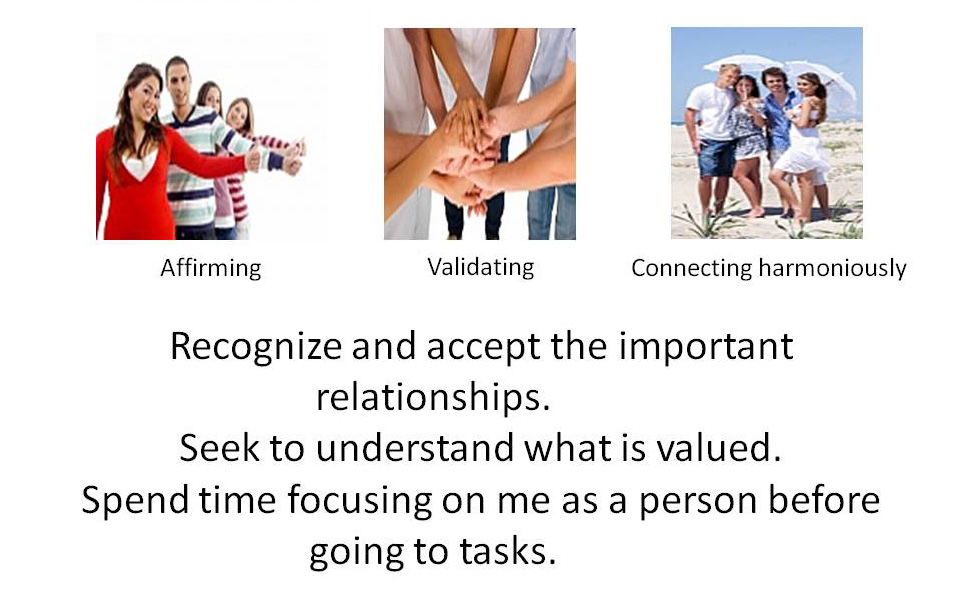 Consideration is about tuning in/noticing/reading the mood or the practical needs of others and then addressing or satisfying those needs.
Consideration is about tuning in/noticing/reading the mood or the practical needs of others and then addressing or satisfying those needs.

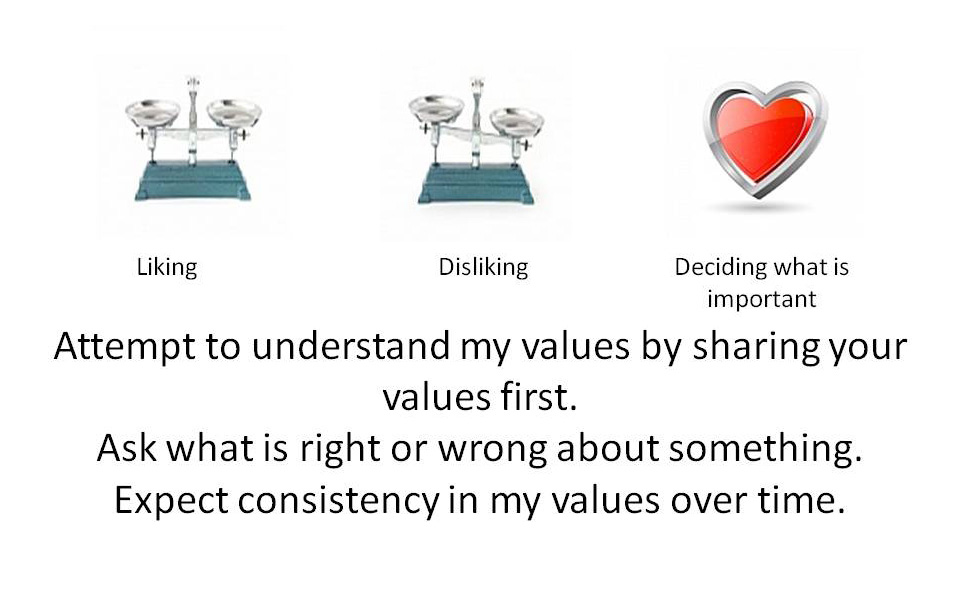 Value evaluates information based on one's unique values. It is easy for one to apply these values to identify what is right, but it is difficult for one to explain to others what one is using to determine what is right.
Value evaluates information based on one's unique values. It is easy for one to apply these values to identify what is right, but it is difficult for one to explain to others what one is using to determine what is right.